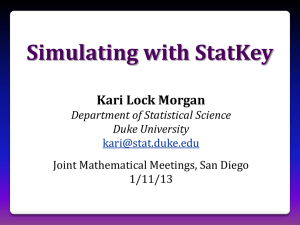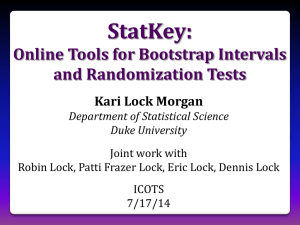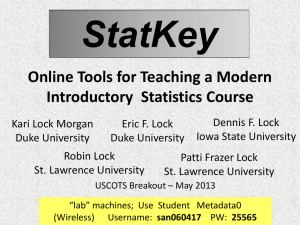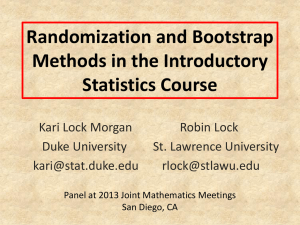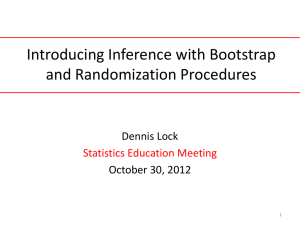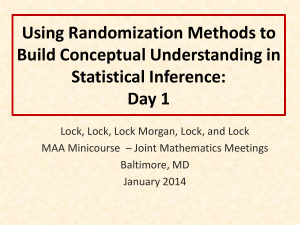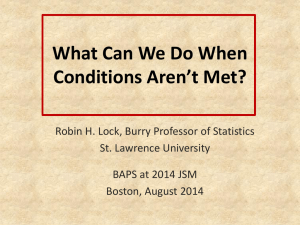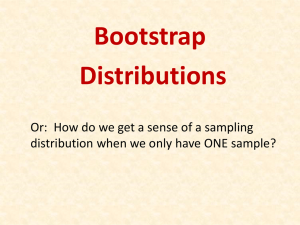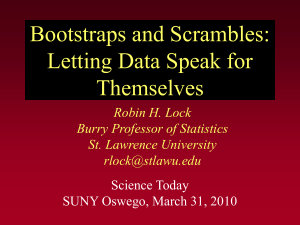- Unlocking the Power of Data
advertisement
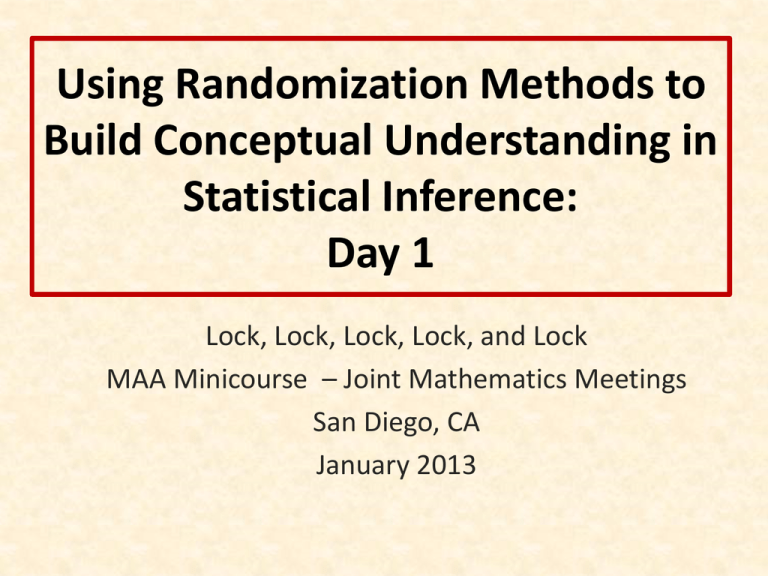
Using Randomization Methods to Build Conceptual Understanding in Statistical Inference: Day 1 Lock, Lock, Lock, Lock, and Lock MAA Minicourse – Joint Mathematics Meetings San Diego, CA January 2013 The Lock5 Team Dennis Iowa State Robin St. Lawrence Patti St. Lawrence Kari Duke Eric Duke Introductions: Name Institution Schedule: Day 1 Wednesday, 1/9, 9:00 – 11:00 am 1. Introductions and Overview 2. Bootstrap Confidence Intervals • What is a bootstrap distribution? • How do we use bootstrap distributions to build understanding of confidence intervals? • How do we assess student understanding when using this approach? 3. Getting Started on Randomization Tests • What is a randomization distribution? • How do we use randomization distributions to build understanding of p-values? 4. Minute Papers Schedule: Day 2 Friday, 1/11, 9:00 – 11:00 am 5. More on Randomization Tests • How do we generate randomization distributions for various statistical tests? • How do we assess student understanding when using this approach? 6. Connecting Intervals and Tests 7. Connecting Simulation Methods to Traditional 8. Technology Options • Brief software demonstration (Minitab, Fathom, R, Excel, ...) – pick one! 9. Wrap-up • How has this worked in the classroom? • Participant comments and questions 10. Evaluations Why use Randomization Methods? These methods are great for teaching statistics… (the methods tie directly to the key ideas of statistical inference so help build conceptual understanding) And these methods are becoming increasingly important for doing statistics. It is the way of the past… "Actually, the statistician does not carry out this very simple and very tedious process [the randomization test], but his conclusions have no justification beyond the fact that they agree with those which could have been arrived at by this elementary method." -- Sir R. A. Fisher, 1936 … and the way of the future “... the consensus curriculum is still an unwitting prisoner of history. What we teach is largely the technical machinery of numerical approximations based on the normal distribution and its many subsidiary cogs. This machinery was once necessary, because the conceptually simpler alternative based on permutations was computationally beyond our reach. Before computers statisticians had no choice. These days we have no excuse. Randomization-based inference makes a direct connection between data production and the logic of inference that deserves to be at the core of every introductory course.” -- Professor George Cobb, 2007 (see full TISE article by Cobb in your binder) Question Do you teach Intro Stat? A. Very regularly (most semesters) B. Regularly (most years) C. Occasionally D. Rarely (every few years) E. Never (or not yet) Question How familiar are you with simulation methods such as bootstrap confidence intervals and randomization tests? A. Very B. Somewhat C. A little D. Not at all E. Never heard of them before! Question Have you used randomization methods in Intro Stat? A. Yes, as a significant part of the course B. Yes, as a minor part of the course C. No D. What are randomization methods? Question Have you used randomization methods in any statistics class that you teach? A. Yes, as a significant part of the course B. Yes, as a minor part of the course C. No D. What are randomization methods? Intro Stat – Revise the Topics • • •• • • • • Descriptive Statistics – one and two samples Normal distributions Bootstrap confidence intervals Data production (samples/experiments) Randomization-based hypothesis tests Sampling distributions (mean/proportion) Normal distributions Confidence intervals (means/proportions) • Hypothesis tests (means/proportions) • ANOVA for several means, Inference for regression, Chi-square tests We need a snack! What proportion of Reese’s Pieces are Orange? Find the proportion that are orange for your “sample”. Proportion orange in 100 samples of size n=100 BUT – In practice, can we really take lots of samples from the same population? Bootstrap Distributions Or: How do we get a sense of a sampling distribution when we only have ONE sample? Suppose we have a random sample of 6 people: Original Sample Create a “sampling distribution” using this as our simulated population Bootstrap Sample: Sample with replacement from the original sample, using the same sample size. Original Sample Bootstrap Sample Simulated Reese’s Population Sample from this “population” Original Sample Create a bootstrap sample by sampling with replacement from the original sample. Compute the relevant statistic for the bootstrap sample. Do this many times!! Gather the bootstrap statistics all together to form a bootstrap distribution. Original Sample Bootstrap Sample Bootstrap Statistic Bootstrap Sample Bootstrap Statistic ● ● ● ● ● ● Sample Statistic Bootstrap Sample Bootstrap Statistic Bootstrap Distribution Example: What is the average price of a used Mustang car? Select a random sample of n=25 Mustangs from a website (autotrader.com) and record the price (in $1,000’s) for each car. Sample of Mustangs: MustangPrice 0 5 Dot Plot 10 15 20 25 Price 30 35 40 45 𝑛 = 25 𝑥 = 15.98 𝑠 = 11.11 Our best estimate for the average price of used Mustangs is $15,980, but how accurate is that estimate? Original Sample Bootstrap Sample We need technology! Introducing StatKey. www.lock5stat.com/statkey StatKey Std. dev of 𝑥’s=2.18 Using the Bootstrap Distribution to Get a Confidence Interval – Method #1 The standard deviation of the bootstrap statistics estimates the standard error of the sample statistic. Quick interval estimate : 𝑂𝑟𝑖𝑔𝑖𝑛𝑎𝑙 𝑆𝑡𝑎𝑡𝑖𝑠𝑡𝑖𝑐 ± 2 ∙ 𝑆𝐸 For the mean Mustang prices: 15.98 ± 2 ∙ 2.18 = 15.98 ± 4.36 = (11.62, 20.34) Using the Bootstrap Distribution to Get a Confidence Interval – Method #2 Chop 2.5% in each tail Keep 95% in middle Chop 2.5% in each tail We are 95% sure that the mean price for Mustangs is between $11,930 and $20,238 Bootstrap Confidence Intervals Version 1 (Statistic 2 SE): Great preparation for moving to traditional methods Version 2 (Percentiles): Great at building understanding of confidence intervals Playing with StatKey! See the purple pages in the folder. Traditional Inference CI for a mean 1. Which formula? 𝑥 ± 𝑧∗ ∙ 𝜎 OR 𝑛 𝑥 ± 𝑡∗ ∙ 𝑠 2. Calculate summary stats 𝑛 = 25, 𝑥 = 15.98, 𝑠 = 11.11 3. Find t* 95% CI 𝛼 4. df? 2 = 1−0.95 2 df=25−1=24 = 0.025 t*=2.064 5. Plug and chug 15.98 ± 2.064 ∙ 11.11 25 15.98 ± 4.59 = (11.39, 20.57) 6. Interpret in context 7. Check conditions 𝑛 We want to collect some data from you. What should we ask you for our one quantitative question and our one categorical question? What quantitative data should we collect from you? A. What was the class size of the Intro Stat course you taught most recently? B. How many years have you been teaching Intro Stat? C. What was the travel time, in hours, for your trip to Boston for JMM? D. Including this one, how many times have you attended the January JMM? E. ??? What categorical data should we collect from you? A. B. C. D. E. Did you fly or drive to these meetings? Have you attended any previous JMM meetings? Have you ever attended a JSM meeting? ??? ??? Why does the bootstrap work? Sampling Distribution Population BUT, in practice we don’t see the “tree” or all of the “seeds” – we only have ONE seed µ Bootstrap Distribution What can we do with just one seed? Bootstrap “Population” Estimate the distribution and variability (SE) of 𝑥’s from the bootstraps Grow a NEW tree! 𝑥 µ Golden Rule of Bootstraps The bootstrap statistics are to the original statistic as the original statistic is to the population parameter. How do we assess student understanding of these methods (even on in-class exams without computers)? See the green pages in the folder. Paul the Octopus http://www.youtube.com/watch?v=3ESGpRUMj9E http://www.cnn.com/2010/SPORT/football/07/08/germany.octopus.explainer/index.html Paul the Octopus • Paul the Octopus predicted 8 World Cup games, and predicted them all correctly • Is this evidence that Paul actually has psychic powers? • How unusual would this be if he were just randomly guessing (with a 50% chance of guessing correctly)? • How could we figure this out? Simulate! • Each coin flip = a guess between two teams • Heads = correct, Tails = incorrect • Flip a coin 8 times and count the number of heads. Remember this number! Did you get all 8 heads? (a) Yes (b) No Hypotheses Let p denote the proportion of games that Paul guesses correctly (of all games he may have predicted) H0 : p = 1/2 Ha : p > 1/2 Randomization Distribution • A randomization distribution is the distribution of sample statistics we would observe, just by random chance, if the null hypothesis were true • A randomization distribution is created by simulating many samples, assuming H0 is true, and calculating the sample statistic each time Randomization Distribution • Let’s create a randomization distribution for Paul the Octopus! • On a piece of paper, set up an axis for a dotplot, going from 0 to 8 • Create a randomization distribution using each other’s simulated statistics • For more simulations, we use StatKey p-value • The p-value is the probability of getting a statistic as extreme (or more extreme) as that observed, just by random chance, if the null hypothesis is true • This can be calculated directly from the randomization distribution! StatKey 12 8 0.0039 Randomization Test • Create a randomization distribution by simulating assuming the null hypothesis is true • The p-value is the proportion of simulated statistics as extreme as the original sample statistic Coming Attractions - Friday • How do we create randomization distributions for other parameters? • How do we assess student understanding? • Connecting intervals and tests • Connecting simulations to traditional methods • Technology for using simulation methods • Experiences in the classroom
